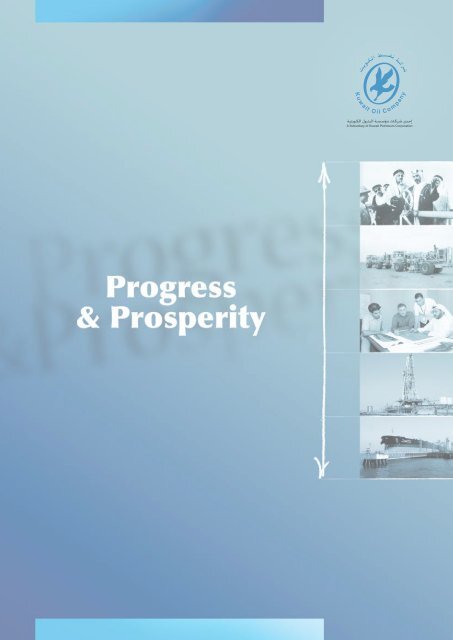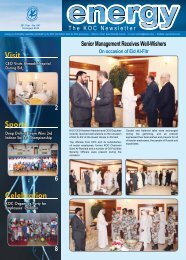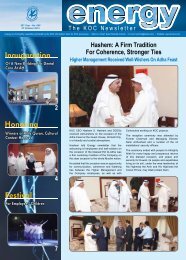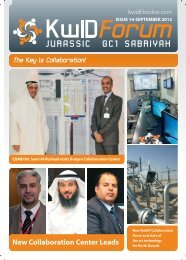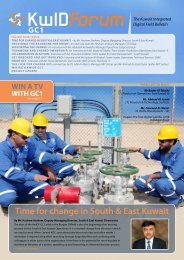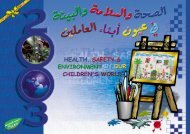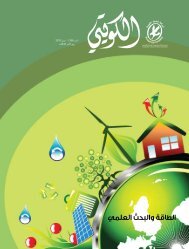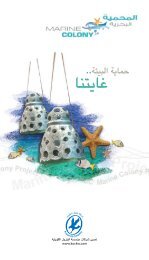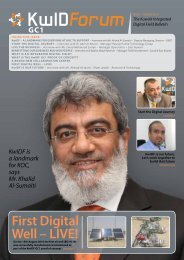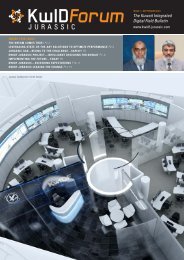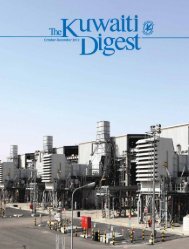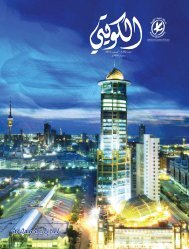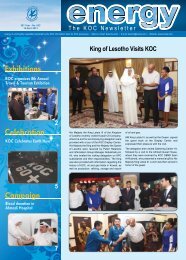Progress and Prosperity-English - Kuwait Oil Company
Progress and Prosperity-English - Kuwait Oil Company
Progress and Prosperity-English - Kuwait Oil Company
Create successful ePaper yourself
Turn your PDF publications into a flip-book with our unique Google optimized e-Paper software.
<strong>Progress</strong> & <strong>Prosperity</strong>HISTORICAL INSIGHT<strong>Kuwait</strong> <strong>Oil</strong> <strong>Company</strong> (KOC) was established in 1934under joint ownership agreement between the Anglo-Iranian<strong>Oil</strong> <strong>Company</strong>, now known as British Petroleum<strong>and</strong> Gulf <strong>Oil</strong> Corporation known today asChevron. The company was given free concessionrights to explore <strong>and</strong> produce oil in state of <strong>Kuwait</strong>.Exploration activities began soon after; surface geologystudies <strong>and</strong> gravity surveys were conducted.In 1936 KOC drilled the first exploratory well innorth Bahra area but the results were not encouragingenough to continue.In 1938 oil was discovered in Burgan well–1. Duringthe following years, eight exploration <strong>and</strong> appraisalwells were drilled which established “Burgan” asone of the largest producing oil fields in the world.However, drilling <strong>and</strong> production operations weresuspended due to the eruption of World War II. Afterthe end of the war in 1945, operations were resumed<strong>and</strong> the eight drilled wells produced at a rateof 30,000 bpd. Surface facilities, pipe lines, exportingfacilities… etc had been constructed <strong>and</strong> <strong>Kuwait</strong> wasready for new era of prosperity.In June 30, 1946 His Highness the late Sheikh AhmadAl-Jaber, then Amir of <strong>Kuwait</strong>, inaugurated the firstshipment of oil when he turned the silver wheeledvalve to start loading of the first flow of oil onto the12,000 tonne “British Fuzilier” tanker.Following the early success, more appraisals <strong>and</strong>development well were drilled in Burgan field to increaseproduction. In 1951, explorations operationswere extended into Magwa <strong>and</strong> Ahmadi ridge area,oil was discovered <strong>and</strong> production began from theMagwa field in 1953.Exploration activities continued in the following yearsleading to the discovery of Raudhatain field in north<strong>Kuwait</strong> <strong>and</strong> Minagish field in west <strong>Kuwait</strong> in 1955.In 1974 a partnership was ratified by <strong>Kuwait</strong> NationalAssembly giving 60% control of the operations<strong>and</strong> facilities of KOC to the State of <strong>Kuwait</strong> whileremaining 40% were divided equally between BP<strong>and</strong> Gulf.4
In 1975 the <strong>Kuwait</strong> government assumed full ownershipof the company.In 1980, it was about time to organize the oil sector.<strong>Kuwait</strong> petroleum Corporation (KPC) was establishedby an Amiri Decree.KOC was given the responsibility of on-shore offshoreexploration, drilling, development, <strong>and</strong> productionof hydrocarbon in the state of <strong>Kuwait</strong>.In 1981 KOC conducted an on-shore off-shore 2Dseismic survey for development <strong>and</strong> explorationobjectives. This was followed by successful drillingprogram to increase production from the discoveredfields. In 1983 KOC commenced its first off-shoreexploration drilling. Four prospects were drilled usingAl-Baz rig with no economical discoveries but oilshows were reported.Between August 1990 <strong>and</strong> February 1991, nearly80% of KOC producing wells, installations <strong>and</strong> facilitieswere destroyed in the wake of the Iraqi invasion.Their complete restoration in less than four years wasachieved as result of the remarkable level of cooperationbetween KPC subsidiaries, <strong>and</strong> in tribute to<strong>Kuwait</strong>i National pride.H.H the Amir Sheikh Jaber Al-Ahmed Al-Jaber Al-Sabah personally capped Burgan 118 on November6, 1991, 18 months ahead of international forecast.This was the result of more than 700 oil wells setablaze by the Iraqis. The first post-liberation shipmentof 1.64 million barrels of crude oil left <strong>Kuwait</strong>in July 1991, by September of the same year newwells were under construction <strong>and</strong> crude oil productiononce again exceeded the two million barrels perday level by February 1993.The strategic goals of KOC were to increase oil <strong>and</strong>gas reserves <strong>and</strong> production. Plans were establishedfollowing the liberation. In 1995 extensive exploration<strong>and</strong> development programs were designed.Thous<strong>and</strong>s of 2D, 3D <strong>and</strong> 4D Seismic data were acquiredover the whole l<strong>and</strong> area, Bubiyan Isl<strong>and</strong> <strong>and</strong>transition zone. In December 30 of the same yearthe company signed a contract with Chinese PetroleumCorporation to build gathering centers 27 <strong>and</strong>28 in west <strong>Kuwait</strong>. In January 9, 1996 two rotaryplatforms were constructed.In March 1997, the Ahmadi Park was renovated,decorated <strong>and</strong> reopened under the patronage ofthen Ahmaid governor Sheikh Ali Jaber Al-AhmadAl-Sabah. In March 1998, Ahmadi sports day was recelebratedafter the company has rebuilt the sporting,entertainment <strong>and</strong> social facilities.5
<strong>Progress</strong> & <strong>Prosperity</strong>In April 1998, the chairman’s HSE award was implemented.The <strong>Company</strong>’s various activities continued at all levels.In March 2000, the 14th Ahmadi Sports Day washeld.In July 2000 gathering center 25 north of <strong>Kuwait</strong> wascommissioned. In January <strong>and</strong> April 2001 gatheringcenters (27), (28) in west <strong>Kuwait</strong> fields were respectivelyinaugurated <strong>and</strong> commissioned.In 2003, KOC jointly with major seismic companytested the use of digital single sensors to acquire highresolution 3D Seismic data in Minagish field.In 2003/2005 KOC acquired 1650 sq. km of 3DSeismic cover, Ratqa, Mutriba, Ladira, Dhabi <strong>and</strong>Raudhatain areas.KOC has launched its ambitious 2020 strategy whichcalls for increasing oil <strong>and</strong> gas reserves <strong>and</strong> increaseproduction.Exploration activities have been intensified in orderto achieve the strategy. Exploration studies <strong>and</strong> drillinghave been focused on the hydrocarbon potentialsof the deep Jurassic <strong>and</strong> Permian reservoirs.These intense exploration drilling activities have resultedon several significant light oil <strong>and</strong> gas discoveries.SA-153 (1999-Marrat, 2002-Najmah/Sargelu) MiddleMarrat interval was tested <strong>and</strong> produced 15.7MMSCFD gas, with condensate @ 4500 BCPD.Najmah/Sargelu interval was tested <strong>and</strong> produced14 MMSCFD gas with condensate @ 4510 BCPD.RA-206 (2002-Marrat) exploratory well MiddleMarrat interval was tested <strong>and</strong> the well producedlight crude oil (46o API) @3869 bopd of oil with gaspotential of 8.55mmscf/day.NWRA-01 (2002-Marrat) Middle Marrat intervalwas tested @ 5189 bopd of (43o API) oil <strong>and</strong> associatedgas 11.5 MMSCFD.KA-01 (2002-Marrat) discovery of 40 API oil wasmade in Middle Marrat produced 323 bopd of oilwith GOR of 1070scf/bbl.SA-072 (2003-Marrat) The well has been completedin Middle Marrat <strong>and</strong> produced 8.2 MMSCFD gaswith condensate @ 4532 BCPD.KA-01 (2004-Najmah/Sargelu) Well KA-01ST(SideTrack) has produced from Najmah Sargelu reservoirthrough 32/64” @ 1876 BOPD, API: 49°, GOR:1795 SCF/bblBahrah-28 (2004 Middle Marrat) First commercial6
quantities of light oil in Bahrah Field in the veryfirst Jurassic well. The post-acidization test resultsthrough 32/64” choke @ 4860 BOPD, API: 44°, GasRate: 12.670 MMSCFDRA-230 (2005-Middle Marrat) <strong>Oil</strong>: 4963 BOPD,Gas: 14.0 MMSCFD, FWHP: 5933 PSI,RA-236 (2006-Middle Marrat) <strong>Oil</strong>: 5245 BOPD,Gas: 15.2 MMSCFD,These discoveries (RA-230/236) have confirmed theextent of high quality oil in Raudhatain structure.RH-02 (2003-Marrat,2004-Najmah/Sargelu) exploratorywell Middle Marrat interval was tested <strong>and</strong>the well flowed 46 API OIL @ 2352bopd of oil withGOR of 1627scf/bbl. Najmah/Sargelu interval wastested <strong>and</strong> produced light crude (52o API) @5702bopd with GOR of 2582 Scf/bbl <strong>and</strong> associated gas@ 14.7 MMSCFD.The highest quality oil in <strong>Kuwait</strong> <strong>and</strong> proved oil 1500feet deeper than the known Minagish field.UN-01(SA-215)_2005 Middle Marrat Test-1Gas rate: 16.8 MMSCFD, Condensate rate: 3052BCPDMiddle Marrat Test-2Gas rate: 14 MMSCFD, Condensate rate: 2738 BCPDMiddle Marrat Test-3Gas rate: 14.4 MMSCFD, Condensate rate: 2455BCPD,Upper Marrat TestGas rate: 10.206 MMSCFD, Condensate rate:1879 BCPDNajamh/Sargelu TestGas rate: 27.132 MMSCFD, Condensate rate:2153 BCPDNWRA-02 (Najmah/Sargelu)-2005 Has been thesecond gas condensate discovery in North <strong>Kuwait</strong>from Najmah/Sargelu. Gas: 19.1 MMSCFD, Condensaterate: 3571 BCPD.Arifjan-01(Marrat)-2006 Located SE of BurganStructure this well has produced oil @ rate 5357BOPDAPI: 42°, Gas rate: 8.336 MMSCFDUR-01(Marrat)-2007 Located on Minagish _ RahayiahTrend the UR-01 have produced oil @:679 BOPD, API: 43UN-02(Marrat)-2007 has produced Gas @ rate:19 MMSCFD <strong>and</strong> Condensate @ rate: 2063BCPDThese major light oil <strong>and</strong> gas discoveries have established<strong>Kuwait</strong> on the world map of gas producingcountries.7
<strong>Progress</strong> & <strong>Prosperity</strong>EXPLORATION & DRILLING OPERATIONS<strong>Oil</strong> Origin & Formation:<strong>Oil</strong> is formed from the remains of numerousanimals <strong>and</strong> plants that lived <strong>and</strong> died in the seamillions of years ago. Covered beneath hundredof tons of rocks <strong>and</strong> subject to high pressures<strong>and</strong> temperatures, bacterial reactions take placein these organic materials to form oil.Locations of <strong>Oil</strong>:<strong>Oil</strong> exists within the porous layers of sedimentaryrocks that have been trapped for millions ofyears by a covering of non-porous “cap” rocks.Sedimentary rocks are formed from silt, s<strong>and</strong> orthe debris of shells precipitated at the bottomof ancient seas <strong>and</strong> it is these sedimentary rocksthat oil explorers search for.Exploration:Exploration process is divided into several phases.It begins with identifying a specific locationin which geologists expect availability of mainfactors for oil reservoirs formation. At this point,geologists make recommendations to conductcertain geological surveys which are divided intoseveral types according to the type of informationneeded to be collected. Such surveys areconcerned with studying physical properties ofearth layers through conducting measurementsfor physical fields on <strong>and</strong> near l<strong>and</strong> surveys. Theimportance of these surveys is that they reduceexploration drilling risks. The types of these surveysare set out below:8
<strong>Progress</strong> & <strong>Prosperity</strong>rock porosity <strong>and</strong> permeability within oil reservoirs.The four dimensional (4D) seismic surveyshave been recently introduced. This techniqueprovides information on the fluid movementswithin producing reservoirs.The accuracy of the results of the seismic surveysgreatly enhances the success of explorationdrilling.After obtaining these surveys <strong>and</strong> analyzinginformation, geologists team perform the nextphase which includes many geological studiesusing the information gathered through geophysicalsurveys in addition to information madeavailable from neighboring wells, if any. Someof these studies are mentioned hereunder:· Constructive Geological Studies:Concerned with the study of the Geology ofstrata based on the structure <strong>and</strong> the changesof the appearance of traps <strong>and</strong> potential for oilentrapment within oil traps in addition to identificationof types of folds <strong>and</strong> drifts that mayexist in the oil field <strong>and</strong> have positive or negativeimpact on traps according to type of layers.· Sedimentary Geological Studies:Geological Studies including the study of sedimentarysequences in respect to the type ofrocks <strong>and</strong> entrapment mechanism, migrationbefore or after the trap formation <strong>and</strong> also thepresence of the sealing rocks for hydrocarbonpreservation.· Basin Analysis:Concerned with the general studies of the sedimentarybasins <strong>and</strong> their distribution, the typesof the sedimentary rocks, the geologic structures<strong>and</strong> the potentialities of hydrocarbon occurrences<strong>and</strong> the optimum location of entrapment <strong>and</strong>the nature of the reservoir rocks <strong>and</strong> its extension<strong>and</strong> geographic distribution.· Geochemical Studies:Method involves chemical principle to characterizesource rock, its thermal maturity for hydro-10
carbon generation <strong>and</strong> migration in basin <strong>and</strong> tocorrelate the oil-oil <strong>and</strong> oil source rock samples.In addition, to identify various reservoir alterationsof particular oil occurrence.· Economic Feasibility Prospect Evaluation:The prospective evaluation is dual with economicsof the potential traps after running the technicalgeological & geophysical studies/surveysfor defining the oil entrapment. The assessmentof the economical value of these traps is veryessential to show the elements of risk analysis,the oil in place <strong>and</strong> the recoverable reserves, theexploration <strong>and</strong> development cost estimates foreconomic feasibilities.After completion of all required studies <strong>and</strong> identificationof economic feasibility for the reservoirintended for exploration, geologists provide recommendationswhich include explanation for allprevious phases in addition to one or two locationsthat have been identified through studiesto conduct drilling indicating risk rate <strong>and</strong> thedifference between one site <strong>and</strong> the other.All these studies are then highlighted by drillingexploration wells to prove oil presence, wherethese wells may be drilled to intermediate ordeeper depths. After the completion of explorationdrilling <strong>and</strong> oil has been discovered, theprospects are then transferred to the next phase,which is the delineation & appraisal drilling todefine the boundaries of the discovered field<strong>and</strong> to assess the recoverable oil reserves.هذا11
<strong>Progress</strong> & <strong>Prosperity</strong>STRATEGY (2020)In 2005 <strong>Kuwait</strong> <strong>Oil</strong> <strong>Company</strong> launched its ambitiousstrategy for 2020 which aims to increaseproduction to four million barrels per day, increaseoil reserves <strong>and</strong> explore gas. Appropriate<strong>and</strong> deliberate plans were developed to achievethese objectives in all fields of exploration, drilling<strong>and</strong> development. Exploratory drilling operationsresulted in many significant explorations of lightoil <strong>and</strong> gas. This gives importance <strong>and</strong> strategicdimension to exploration operations <strong>and</strong> achievingthe <strong>Company</strong> ambitious plans as well as establishinghistory of <strong>Kuwait</strong> joining gas producingcountries forum.The strategy is based on the following sevenaxes:1- Production Capacity2- Increase Reserves3- Gas exploration <strong>and</strong> Production4- Health, Safety & Environment5- Research & Technology6- Regulatory Culture <strong>and</strong> the <strong>Company</strong> Image7- Support Services12
DRILLING OPERATIONSDefinition:Drilling is a mechanical process that requires specialtools <strong>and</strong> technology. Equipment is used to penetratethe earth to recover oil <strong>and</strong> gas found in the subsurfacelayers.Once an exact spot on the surface is determined, drillingoperations begin. Drilling operations are in accordancewith a schedule indicating the depth of the well <strong>and</strong> thedifferent size casings to be placed in the well at differentdepths. These casings are used to protect the well fromcorrosion <strong>and</strong> to prevent fluids from entering the hole.Drilling fluid:Drilling fluid or mud is basically a mixture of water, clay,minerals <strong>and</strong> chemicals. Drilling mud is pumped downthe hole through the drill pipe <strong>and</strong> the drill collars <strong>and</strong>exits at the bit through the nozzle <strong>and</strong> heads back upthe hole to the surface through the annulus, a spacebetween the outside of the drill strings <strong>and</strong> the wall ofthe hole.Drilling fluids are used to:- Flush cuttings from the hole.-Cool <strong>and</strong> lubricate the bit <strong>and</strong> ease the rotation of itscones.- Support the walls of the well from caving in <strong>and</strong> preventthe flow of gas <strong>and</strong> oil into the formations duringdrilling operations.Casing <strong>and</strong> tubing:Casing <strong>and</strong> tubing are precision made steel pipes ofvarious sizes <strong>and</strong> specification. At intervals a drill holeis lined with “casing” which is inserted from top to bottom<strong>and</strong> cemented into position.Main uses of casing are:- To control high <strong>and</strong> low pressure formations.- To prevent the hole from caving in.- To replace the flow of oil “production from casing”.- To produce oil from different formations, “dual producer”.Drilling Techniques:Wildcat drilling is considered one of the most expensive<strong>and</strong> difficult drilling of all. This type is carried out todetermine whether gas or oil accumulations exist in theexplored area. Another drilling technique is developmentaldrilling.Work-over operations are carried out by work-over rigs.13
<strong>Progress</strong> & <strong>Prosperity</strong>When the rig moves over a well, first the well has tobe stopped flowing or “killed”. This is usually done byforcing the oil back into the formation with pumpingsuitable saline fluid to overcome the production pressure.When the well is killed, the Christmas tree canthen be removed <strong>and</strong> blowout prevents are fitted, afterwhich the tubing can be pulled out of the hole <strong>and</strong>work-over is carried out. Since the first well was drilledin search for oil at mid 19th century, there have beenmassive developments in the tools, technology <strong>and</strong>methods of drilling. The rotary drilling technique allowsus drill to greater depth in shorter periods of time. Thiswas followed y turbine drilling which used the turbinesinside the well to directly rotate the drilling bit.Due to the awkward location of some drilling sites inresidential, archeological <strong>and</strong> offshore areas, directionaldrilling was developed. Also in line with these developmentsis the horizontal drilling which became anothermethod used in production. It is also one of the methodsused in supported recovery. In comparison withother production methods, horizontal drilling increasesproduction rates, as well as the percentage of oil recoveredfrom the reservoir.Offshore Drilling:Offshore Drilling is very similar to onshore, the chief differentbeing the rigs used to drill offshore wells.The rigs used to drill offshore wells are installed on mobileplatforms pinned to the seabed by means of pilesdriven into the sea-floor. They can be moved easily fromone location to another. The platform is designed tohold the equipment, drilling materials <strong>and</strong> small facilities.Offshore drilling cost is higher than terrestrial drilling.wells are wells of lesser depths, beginning at a depthof about 850-7000 feet <strong>and</strong> averaging to about 7000-12000 feet. There are much deeper wells of about20,000 feet.Recently, <strong>Kuwait</strong> <strong>Oil</strong> <strong>Company</strong> has introduced a numberof modern techniques, the most notable of which ishorizontal drilling. This type of drilling method is carriedout drilling a vertical hole to the producing zone,then followed by horizontal drilling. The advantagesof this type of drilling are that it increases productionfrom certain formations <strong>and</strong> reduces the cost over thelong-term.The <strong>Company</strong> is currently carrying out deep exploratorydrilling to search for new formations <strong>and</strong> to prospectfor gas.Drilling Workshops:Workshops <strong>and</strong> Stores carry out the following:- The storage of equipment <strong>and</strong> materials required fordrilling operations.- Coordinate between the concerned parties <strong>and</strong> theDrilling Dept.- Planning <strong>and</strong> scheduling of drilling rig movement.- Supply <strong>and</strong> provide materials <strong>and</strong> equipment to thedrilling sites.Drilling Water Wells:In addition to the drilling of oil wells, there are also waterwell drilling operations. These wells are drilled inorder to supply rigs <strong>and</strong> Gathering Centers with water.Also, wells are drilled to protect oil wells from corrosion,referred to as cathodic protection.Drilling wells in <strong>Kuwait</strong>:The wells in <strong>Kuwait</strong> are drilled vertically. Within these14
FIELDS DEVELOPMENT1- RESERVOIR GEOLOGY<strong>Oil</strong> is usually found in pores <strong>and</strong> vugs of reservoirrocks. These rocks are in most of thecases of s<strong>and</strong>stone, limestone or dolomite<strong>and</strong> found underground at different depths.Some reservoir rocks in <strong>Kuwait</strong> are at morethan 7 kilometers depth.The amount of oil or gas in the reservoir rockdepends on many rock physical propertiesout of which porosity (percentage of rockpores to the rock <strong>and</strong> total volume), permeability(how easy fluids can pass throughrock pores), oil saturation, net pay thickness<strong>and</strong> reservoir geometry (Geological structure)are part of it. By determination of allthese reservoir physical parameters, strategicoil reserves can be calculated <strong>and</strong> economicallyevaluated.Identification of type of structural traps isconsidered as the main part in setting theproper Geological Model for each reservoir,which in return facilitates setting the optimumField Development Plan for the reservoir.<strong>Kuwait</strong> <strong>Oil</strong> <strong>Company</strong> is currently utilizingwhat is considered as top of the art in hard-15
<strong>Progress</strong> & <strong>Prosperity</strong>ware <strong>and</strong> software technology in oil industryin order to calculate accurate reservoir rockphysical properties <strong>and</strong> set a most accurateGeological Model for <strong>Kuwait</strong>i oil fields. Thisgoes side by side with the huge measurements<strong>and</strong> studies in lots of directions wherethe following are to be mentioned.Seismic Survey:The surface <strong>and</strong> well seismic survey is consideredas the first step in exploration <strong>and</strong>development of oil fields. It helps to identifythe structural <strong>and</strong> stratigraphic traps thatcan be considered as promising in hydrocarboncontent. Therefore, <strong>Kuwait</strong> <strong>Oil</strong> <strong>Company</strong>has performed what is considered asvast 2D <strong>and</strong> 3D surface seismic survey onall onshre <strong>and</strong> offshore l<strong>and</strong> of <strong>Kuwait</strong> state.Extensive processing <strong>and</strong> interpretation ofthe seismic data have followed this survey inorder to improve the geological model of allreservoirs.Wire-Line Well Logging:International logging contractors working in<strong>Kuwait</strong> are providing wide range of loggingservice, processing <strong>and</strong> interpretation of loggingdata in oil wells on daily basis. These logdata are the only way to predict the physicalproperties of the reservoir rock. Each loggingtool works on a specific technique tomeasure one of the natural responses of thereservoir rock. These responses are interpretedlater to calculate the physical propertiesof the reservoir. Logging technologyis subject to daily development <strong>and</strong> lots ofhigh tech tools are introduced to the marketfrom time to time. <strong>Kuwait</strong> <strong>Oil</strong> <strong>Company</strong>16
is considered one of the leaders in the areain utilizing all the new in this career for thebenefit of <strong>Kuwait</strong> oil industry.Core Sample Analysis:As wire-line logging process does not measuredirect <strong>and</strong> absolute rock propertiesbut depends on interpretation of nature ofrock character to predict rock physical parameters,the need for direct measurementsof rock properties is raised to calibrate logmeasurements. This is being achieved nowby collecting either a full diameter core orside wall core plugs from the reservoir rock.These rock samples are sent to <strong>Kuwait</strong> Institutefor Scientific Research or any other specializedcontractors working in <strong>Kuwait</strong> fordifferent <strong>and</strong> detailed type of measurementsto identify the absolute rock properties ofthe reservoir which facilitates development<strong>and</strong> production process.This type of study is considered one of thelatest technologies used to get more knowledgeabout the reservoir <strong>and</strong> detailed studythereof through incorporating all informationmade available from seismic <strong>and</strong> wireline well log measurements <strong>and</strong> analysis ofcore samples. They assist to build a comprehensivestructure model to interpret <strong>and</strong>evaluate the reservoir internal structure leadingto distribution <strong>and</strong> classification of informationwithin it in 3D vision.17
<strong>Progress</strong> & <strong>Prosperity</strong>2- Development of <strong>Oil</strong> Production Reservoirs:The primary objective of reservoir engineeringis to cost effectively optimize the hydrocarbonrecovery through efficient strategicplanning <strong>and</strong> reservoir management.The <strong>Company</strong> therefore, has undertaken along-term study of the condition <strong>and</strong> behaviorof the oil reservoirs.These studies have become more complicatedwith time. The utilization of new technologies<strong>and</strong> industry modern techniques isvery essential in order to efficiently constructdevelopment plans <strong>and</strong> production strategy.The studies identify the point of force <strong>and</strong>the attributes of a reservoir that control theflow of liquids <strong>and</strong> gases within the reservoirrock <strong>and</strong> into production wells.Reservoir Definition:Reservoir is a subsurface layer having sufficientporosity <strong>and</strong> permeability to store <strong>and</strong>transmit economic quantities of hydrocarbonfluids. <strong>Oil</strong>, gas <strong>and</strong> water contained in thislayer are usually sealed by a relatively impermeableformation through which hydrocarbonswill not flow. Reservoir rock could beeither s<strong>and</strong>stone or carbonates.Areas contribute to enhance Reservoir Development:1- Reservoir rock type (s<strong>and</strong>stone or carbonate)<strong>and</strong> its properties (porosity <strong>and</strong> permeability).2- Fluid properties (viscosity, associated gas,API density…).3- Reservoir geological model showing rock<strong>and</strong> properties distribution.4- Production mechanism (solution gas drive,gas cap drive, water drive).5- Tracking water encroachment.6- Reservoir simulation models.Modern Studies in production Development:In general, the abovementioned studies areapplied to different fields in <strong>Kuwait</strong> such asthe Greater Burgan Field, which containsthe largest S<strong>and</strong>stone reservoir in the world.In order to manage such reservoir, state ofthe art technology needs to be utilized inthe <strong>Company</strong>’s researches <strong>and</strong> studies. Thefollowing are some of the major studiesconducted in the area of reservoir development:1- Post-Blowout status of the reservoir.2- Geological <strong>and</strong> simulation models.3- Water encroachment studies.4- Reserves evaluation studies.5- Production history <strong>and</strong> predicted reservoirsbehavior.18
6- Evaluating different production scenarios<strong>and</strong> determining the feasibility of each scenario.7- Analyzing 2D <strong>and</strong> 3D seismic studies.These studies were carried out for the followingfields in <strong>Kuwait</strong>:FieldsGreater Burgan FieldUmm Gudair FieldMinagish FieldRaudhatainFieldSabriyahFieldMaudoudMaudoudReservoirsBurganWaraMarratMinagishMarratMinagishEast MinagishMarratUpperBurganUpperBurganDownBurganDownBurganZubair3- Petroleum Engineering:Petroleum Engineering is the backbone to alloilfield operations. Hydrocarbon reservoirsneed wells to be completed <strong>and</strong> produced inan appropriate manner to get the best outof this Mother nature’s treasure. Petroleumengineering usually associated with completion,monitoring, evaluation <strong>and</strong> optimizationof well performance. With increasingcomplexity of reservoirs <strong>and</strong> the need toenhance production through secondary <strong>and</strong>tertiary enhanced recovery process, artificiallift etc., the role of petroleum engineers isbecoming ever important to ensure desiredresults.Some major petroleum engineering areasthat are efficiently being dealt with in KOC19
<strong>Progress</strong> & <strong>Prosperity</strong>are outlined below:Well planning, design <strong>and</strong> equipment selection:Each well is planned to meet specified requirements<strong>and</strong> completion designed tomeet required rate conditions. Appropriatecompletion equipment is thus selected keepingin view HSE compliance.Well Engineering:Tubing stress calculations are done for eachwell <strong>and</strong> appropriate completion equipmentis selected to ensure well integrity.Injection well monitoring <strong>and</strong> use of performanceimprovement techniques.Injection well rates & quality are constantlymonitored <strong>and</strong> evaluated. Acid stimulation<strong>and</strong> flow back techniques are being utilizedto improve well performance where appropriate.Balance injection <strong>and</strong> off-take rates for waterflood management:Production <strong>and</strong> injection rates for each waterfloodpattern are assessed <strong>and</strong> adjusted tomaintain optimum sweep.Inhibition of asphaltene/scale/bacterial,etc. deposition:Asphaltene deposition is a problem in someof our oil fields. Many studies have beenconducted to identify the causes of theproblem <strong>and</strong> to devise remedial measures.Chemical squeezes are currently being triedto control/mitigate this problem. Also withonset of water cut in wells scale deposition isa potential problem <strong>and</strong> measures are availableto deal with this through appropriatechemical squeeze treatments.Corrosion monitoring <strong>and</strong> control:Full scale corrosion monitoring <strong>and</strong> controlprocesses are implemented to ensure riskfree operations.Water production control:Water cut is a major problem in wells producingfrom natural/artificial water influxreservoirs. Water production is reduced withcement squeeze jobs where appropriate.20
Artificial lift design, implementation, monitoring<strong>and</strong> optimization:Many type of artificial lift methods such aselectrical submersible pumps, gas lift etc. arealready designed <strong>and</strong> in use in many wells.The performance of these lift mechanism isbeing continuously evaluated.Production well performance monitoring<strong>and</strong> evaluation:All producers are constantly monitored <strong>and</strong>performance is optimized through verticallift performance software.Well integrity assurance:Each well integrity is analyzed through suitablelogs/well performance <strong>and</strong> all remedialmeasures are being taken to ensure well integrity.Surveillance data acquisition <strong>and</strong> evaluation:Surveillance strategy based on prudent reservoirmanagement practices is formulated<strong>and</strong> implemented to acquire required surveillancedata. This is key input for reservoirmanagement <strong>and</strong> highlighting well interventionopportunities.Well Surveillance Division:The division consists of three sections <strong>and</strong>major functions of each section are givenbelow:21
<strong>Progress</strong> & <strong>Prosperity</strong>First: Contract Section:The section is responsible for administrationof various contracts like:1- Electrical submersible pumping lease contracts.2- Gas lift contracts.3- Coiled tubing contracts.4- Well testing contracts.5- Hydrochloric acid supply contracts.6- Preparation of Capital <strong>and</strong> Expense budgets.7- Budget control <strong>and</strong> monthly status reports.8- Processing of contractor’s invoices.Second: Artificial Lift Operation Section:This section is responsible for all field operationsrelated to artificial lifts modes such assubmersible pumping <strong>and</strong> gas lift, etc. Mainfunctions of this section are:1- Supervision of work/overs for installationsof ESPs <strong>and</strong> Gas lift.2- Monitoring <strong>and</strong> trouble shooting of artificiallift installations.3- Verifying contractors service tickets forthe services provided.4- Weekly <strong>and</strong> monthly status reports.Third: Rigless Operations Section:This section is responsible for all wire lineactivities <strong>and</strong> rigless operations as detailedbelow:1- Follow up well measurement activities.2- Well renovation through cleaning operations.3- Slick line works, enlivening wells by swabbing,PLTs, TDTs, pressure/temperature surveys<strong>and</strong> tubing corrosion logs.4- Well productivity measurement processes.5- PVT sampling, production-GOR testingof wells.6- Rigless perforations.7- Well stimulation <strong>and</strong> coiled tubing jobs.8- Increase production through changingproduction layer.9- Reduce water production.10- Treat production deposits11- Treat pipelines from asphaltine <strong>and</strong> limedeposits.12- Well depth control.13- Lift <strong>and</strong> remove equipment <strong>and</strong> wiresdropped into the well.14- Services tickets/invoices verification <strong>and</strong>budget control for related jobs.15- Preparation of monthly status reports.16- Train <strong>and</strong> develop the <strong>Company</strong> petroleumengineers in addition to the students ofFaculty of Engineering & Petroleum in <strong>Kuwait</strong>University <strong>and</strong> PAAET.22
Legacy CircleThe Legacy Circle honors alumni,friends, faculty, <strong>and</strong> staff who haveincluded UC Santa Barbara in theirestate plans through some form ofplanned gift. Membership in thesociety is extended to those who havecommunicated to the university theirintention to make a gift through abequest, charitable trust, charitablegift annuity, pooled income funds, lifeinsurance, retirement fund, or a giftof property with a retained life estate.The following generous donors areproviding the legacy of support thatwill enable UC Santa Barbara tocontinue to grow <strong>and</strong> excel.Anonymous (11)Carol* <strong>and</strong> Marshall AckermanDr. Dana T. Aftab ‘85Dr. <strong>and</strong> Mrs. Guenter AhlersElizabeth Allred* ‘62Ms. Janet A. Alpert ‘68Christine <strong>and</strong> Donald AndersonDr. <strong>and</strong> Mrs. Gregory S. Aposperis /’66Ms. Bluma Appel*Louise V. Arnold*Richard F. Aster, Jr.* ‘63, ‘65Dr.* <strong>and</strong> Mrs.* Stuart P. AtkinsMr. Stuart R. AtkinsNatalie O. Atkinson* ‘47Lawrence Badash*Drs. John D. <strong>and</strong> Janice Baldwin /’82,‘84Dr. <strong>and</strong> Mrs. Peter Bancroft ‘41/Virginia Bancroft*Leinie Schilling Bard <strong>and</strong> Archie* BardCharles H. Barnes* ‘34Itzik <strong>and</strong> Marge Barpal ‘68, ‘70/Dr. <strong>and</strong> Mrs. Steven J. Bartlett ‘68/’68,‘70June York Behrens <strong>and</strong> Henry* W.Behren ‘47/ ‘48George Bernard HammerleDonn R. Bernstein H ‘79Mark <strong>and</strong> Susan Bertelsen ‘66/’67Dr. Denise BielbyDr. William T. BielbyAmbassador Barbara K. Bodine ‘70Dr. Eric H. BoehmMs. Helen R. Borges*Irving B. Bricken*Leonard* <strong>and</strong> Gretchan BroomJune <strong>and</strong> Todd* Brouhard ’54/H ’55Dr. <strong>and</strong> Mrs. William A. Bullough ’55,’67, ’70/Mr.* <strong>and</strong> Mrs. Charles BurkeJoseph <strong>and</strong> Nancy* ByrneIna Theresa Campbell*Janet Lea Campbell ’74Mr. <strong>and</strong> Mrs. Roger CappsVernon I.* <strong>and</strong> Mary Low* Cheadle H’90/H ’90Mrs. Isabel K. Chissar*Carolyn* S. Vernon* G. ChristensenMathilda Christiansen Kuehl* ’62David Kam W. <strong>and</strong> Betty Y. ChuMarvin Clarke* ’51Ms. Marjorie A. Cole ’64Flora Courtois*Ruth <strong>and</strong> Nelson* CulverMr.* <strong>and</strong> Mrs.* Eugene DavidsonMr. Burt L. Davis* ’78Mrs. Louise Lowry Davis*Dr. Steven DenBaars <strong>and</strong> Susan Eng-DenBaarsDr. Robert* <strong>and</strong> Mrs. Barbara* B.DeWolfeWilliam <strong>and</strong> Janet Dinsmore ’68/Carol <strong>and</strong> James DixonDean William DornLinda T. Dozier <strong>and</strong> Professor Jeff DozierDrs. Dudley* Duncan <strong>and</strong> Beatrice*Farwell DuncanMrs. Alison Duncan Egus*Mercedes H. EichholzDr. Katherine Esau*Mr. Bulent EzalJoyce <strong>and</strong> Garold Faber ’65/Dr.* <strong>and</strong> Mrs.* Maurice E. FaulknerHoward* <strong>and</strong> Jean FentonVasanti Ferr<strong>and</strong>o Fithian ’60Mr. Peter* R. <strong>and</strong> Mrs. A.* Helen FrickerDrs. Am<strong>and</strong>a Clark Frost <strong>and</strong> Frank Frost’64, ’66, ’75/’55Lloyd* W. Garrison <strong>and</strong> Jane* D.Garrison’41/’41Mr. <strong>and</strong> Mrs. Ben G. Gautier ‘41/Dr. David* <strong>and</strong> Mrs. Patricia* GebhardBeverly*J. Georgeou <strong>and</strong> James*C.Georgeou* /’51Ambassador Don* <strong>and</strong> Marilyn Gevirtz/H ‘96Mr. Blaine GibsonLois <strong>and</strong> Frank* Goodall ‘48/ ‘51Professor <strong>and</strong> Mrs. Chauncey S.GoodrichJames* C. <strong>and</strong> Liz* Greene /’37Dr. John M.* <strong>and</strong> Betty M.* Groebli ‘46/‘52Marc Grossman ‘73Mr. Daniel Haight ‘63Mr. <strong>and</strong> Mrs. Andrew T. Hass, Jr.Chancellor Henry T. Yang leading the procession at commencementDr.* <strong>and</strong> Mrs. Theodore W. Hatlen H’93/Juliane M. HeymanMrs. Ardis O. Higgins* H ‘88Joseph* O.<strong>and</strong> Elizabeth* S. HirschfelderR. Stephen <strong>and</strong> Gail S. HumphreysMs. Alice H. Iverson*Susan Schwank Jamgochian ‘63, ‘81Bonnie <strong>and</strong> Richard Jensen /H ‘06James A. Jimenez*Norman Johnson*Mr. Kenneth Karmiole ‘68Mitchell Kauffman <strong>and</strong> Joanne Moran‘77/Ms. Vivian King ‘87William A. Kitchen <strong>and</strong> Linda R. KitchenR. Marilyn Lee <strong>and</strong> Harvey A. Schneider‘69/Susan <strong>and</strong> Andy LentzMs. Jody A. Linick <strong>and</strong> Mr. ChristerHagghult ‘85/Mrs. Marjorie D. Linton* ‘56Dr.* <strong>and</strong> Mrs. Robert L. Lorden ‘49/Mr. Bruce Lumbard* ‘70Gayle LyndsCarolyn Street Maddock <strong>and</strong> ThomasMaddock ‘61/Miss Margaret Mallory*York T. M<strong>and</strong>raJack* <strong>and</strong> Anthea MannionCarmen Anita Manus TrustRicki Vinyard Marder <strong>and</strong> David Marder‘79Dr. Richard M. Martin <strong>and</strong> Penny J.MartinRonald* L. <strong>and</strong> Carol* Mays ‘58/Nancy McCagney, Ph.D ‘84, ‘91Betty Fobair McDermott ‘51Marilynn <strong>and</strong> James McNamara ‘82/’85Jennifer* <strong>and</strong> Bruce McRoyDr. Walter <strong>and</strong> Mrs. Thelma MeadProfessor Duncan <strong>and</strong> Mrs. SuzanneMellichamp H ’09/ ’70Mr.* <strong>and</strong> Mrs.* Anthony Menk Alex<strong>and</strong>raMeshkov ‘79,’83Dr.* <strong>and</strong> Mrs.* Robert S. MichaelsenIsmene Michou* ‘53Sara Miller McCune H ‘05Julie Ann Mock <strong>and</strong> Kent M. Vining‘75/’70Dr. Alfred Kummer Moir*Mr. <strong>and</strong> Mrs. Chester G. Moore III *64/William R. Moran*Joan F. Mortell*Melvyn L. <strong>and</strong> Edwina L. Mortensen’63, ’65/Margaret C. Mosher* H ’92, The SamuelB. <strong>and</strong> Margaret C. Mosher FoundationIn Loving Memory of Al <strong>and</strong> MarjorieNasserDr. Frank* <strong>and</strong> Mrs. S<strong>and</strong>ra Nicassio ’79/Mrs. Arnold Nordsieck*Dr. Jon A. Norman ’70, ’72George* <strong>and</strong> Vivian ObernDr. Thomas Payne <strong>and</strong> Alice Lewis Payne’65/’65Col.* <strong>and</strong> Mrs.* Maxwell C. Pellish ’61/Garie <strong>and</strong> Ken PerryLaurence PilgeramDr. <strong>and</strong> Mrs. Joseph H. Pollock H’10/George* W. <strong>and</strong> Edith* RickeyDr. Frank W.D. Ries*Carla S. Roddy ’69Mr. <strong>and</strong> Mrs. Bernard S<strong>and</strong>lerDr.* <strong>and</strong> Mrs.* Robert A. Scalapino ’40/Dr.* <strong>and</strong> Mrs.* Richard SchambergHarvey B. <strong>and</strong> Hope M. Schechter ’47/Mr. <strong>and</strong> Mrs. Jeffrey Schlageter ’65,’67/’65Mrs. Judith A. Schnibbe <strong>and</strong> Mr. RichardJ. Schnibbe /’72Hester* <strong>and</strong> Harold* Schoen /’32Mrs. June H. Schuerch*Catherine Schumann*Dr.* <strong>and</strong> Mrs.* Elman ServiceDr.* <strong>and</strong> Mrs.* Alex<strong>and</strong>er SesonskeHarriet <strong>and</strong> Henry SharpC<strong>and</strong>ace A. <strong>and</strong> David L. Short ’67/’62Arthur SilverDr. Vera Skubic*Connie SmithDr. Norman Spears*Margaret Specht*Ms. Sally Andrews Sphar ’73Dean* W. <strong>and</strong> Barbara* F. Spooner’51/’55Judith Cosdon Staplemann <strong>and</strong> JackStapelmann ’63, ’65/Dr. <strong>and</strong> Mrs. Robert M. Talley H ’99/Mr. Don Tosti*Renee Trenholm <strong>and</strong> Susan RomeroMs. Faye M. Ullom* ’47Mr.* <strong>and</strong> Mrs.* Edward ValentineDr. James P. Vanyo*Frank* <strong>and</strong> Frances* Velek ’64/John* <strong>and</strong> Carolyn H.* Wack /’37Ms. Shirley F. Watkins*Drs. Lorraine McDonnell <strong>and</strong> StephenWeatherfordCyndi <strong>and</strong> Stephen Weeks /’71Ms. Claudia D. Weitlanner*Lisa <strong>and</strong> Howard Wenger ’82/’82Hilda <strong>and</strong> Adrian WennerRobert F. Whitlow* ’71June <strong>and</strong> Knox Williams ’59/Dr.* <strong>and</strong> Mrs.* Lawrence WillsonRalph <strong>and</strong> Irene Wilson ‘70/’66Dr.* <strong>and</strong> Mrs.* Samuel A. WofsyJanice* <strong>and</strong> John* ZoegerChancellor’s CouncilThe Chancellor’s Council, UC SantaBarbara’s premier annual givingprogram, recognizes donors of $1,000or more to the university. Thesegifts are essential to building <strong>and</strong>maintaining the overall excellence ofthe campus. They may be unrestrictedfor use where the need is greatest,or restricted to support a specificdepartment or program. UC SantaBarbara honors <strong>and</strong> celebrates alumni,friends, parents, <strong>and</strong> trustees of theUC Santa Barbara Foundation for theirongoing partnership <strong>and</strong> commitmentto the future of this great university.CHANCELLOR’S COUNCILSTORKE ASSOCIATES$50,000 AND ABOVEAnonymous (11)H.R.H. Prince Mohammed bin Fahd binAbdulaziz, The Saudi Royal FamilyMarshall AckermanDr. <strong>and</strong> Mrs. Guenter AhlersDavid <strong>and</strong> Lyn AndersonJody <strong>and</strong> John Arnhold /’75Mr. Richard A. AuhllIsaac <strong>and</strong> Margaret Barpal ‘68, ‘70Susan <strong>and</strong> Riley Betchel ‘78Arlene <strong>and</strong> Barrie BergmanMark <strong>and</strong> Susan Bertelsen ‘66/’67Anton Vonk <strong>and</strong> Diane Boss ‘05Mr. <strong>and</strong> Mrs. William K. Bowes, Jr.Dan <strong>and</strong> Meg BurnhamMrs. Marcia L. Carsey H ‘04Jack <strong>and</strong> Laura DangermondErika Davispartners in innovation • 21
<strong>Progress</strong> & <strong>Prosperity</strong>to Gathering Centers. The wellhead is madeup of an assembly of valves <strong>and</strong> fittings thatcan control the amount of crude oil that isproduced from the well. Wellheads are madeof a special type of metal. They are heavy<strong>and</strong> high-pressured to support the weight ofthe tubing in the well.Pipeline <strong>and</strong> Manifolds for oil <strong>and</strong> gas:A manifold is an accessory system of pipes<strong>and</strong> lines that extend along an area to carrygas, liquefied gas <strong>and</strong> crude oil to the variousfacilities <strong>and</strong> installations in the <strong>Company</strong>. Amanifold is a center for a number of pipelinesthat control the flow of oil <strong>and</strong> gas withthe ability to separate them during maintenance.<strong>Oil</strong> Gathering Centers:Gathering Centers are installations where oil isseparated from high <strong>and</strong> low pressure gases.The two types of gases are then transferredto gas booster stations. Each Gathering Centerreceives oil from a number of wells, determinedaccording to the size <strong>and</strong> productioncapacity of the Center. Most GatheringCenters accommodate 30 wells at least. Eachone of the wells is distinguished from oneanother in terms of pressure, amount of saltfound, production method used <strong>and</strong> depth.Gas Booster Stations:The gas which is separated in Gathering Centersis sent to these stations, then it is compressed<strong>and</strong> transmitted to the petroleumcondensation plant. Before gas is transferredto the refineries it passes through a water removalsystem.Under high <strong>and</strong> low pressure, liquefied petroleumgas is produced. The gas passes24
through the water removal plant a secondtime <strong>and</strong> is transferred to refineries in Shuaiba.Water Injection:A method of re-injecting effluent or surpluswater into the earth’s high-pressure reservoirs.The internal pressure of the well canbe maintained or dispose of produced waterinto reservoirs allocated for this purpose byusing this method.Gas Injection:A method of re-injecting surplus gas into theearth’s high-pressure reservoirs. The internalpressure of the well can be maintained by usingthis method.Steam Injection:Similar to the method used in gas injection<strong>and</strong> is used to maintain production.Manifold where oil from Gathering Centersis combined:Gathering Centers pipeline converge at themain manifold. A manifold connects betweenthe crude oil system <strong>and</strong> the oil tankfarms.Tank Farms:A group of tanks to collect <strong>and</strong> store thecrude before the transfer to the loading facilitiesfor export. There are a total of 56tanks, 24 in the North Tank Farm <strong>and</strong> 22 inthe South Tank Farm with a total storage capacityof about 16 million barrels.2- Export Pipelines:<strong>Oil</strong> is exported from the South Tank Farmthrough pipelines. It flows through a grav-25
<strong>Progress</strong> & <strong>Prosperity</strong>ity manifold connected to the South TankFarm.These pipelines extended to the South Pier<strong>and</strong> single point mooring <strong>and</strong> supply the refineries<strong>and</strong> power stations.<strong>Oil</strong> is exported from the North Tank Farmthrough four pipelines which are connectedto gravity manifolds of North Tank Farm.Three of the pipelines extend to the NorthPier <strong>and</strong> to the SPM pump house at MinaAl-Ahmadi.· Pump House (gravity line):<strong>Oil</strong> is exported through use of gravity flowlines. The pumping units located in Mina Al-Ahmadi are used when high export flow rateis needed.· Crude <strong>Oil</strong> Control Room:All operations including mixing, storing <strong>and</strong>exporting of crude oil are controlled in thisroom using sophisticated <strong>and</strong> advancedequipment. Construction of this Center wascompleted in 1994.· Old South Pier:It was constructed in Mina Al-Ahmadi in1949 <strong>and</strong> it includes 7 berths in 40-49ft. indepth.Due to old construction of this pier, a newpier was constructed near thereto including7 berths in 40-49 ft. in depth, out of which3 berths are equipped with facilities for loadingcrude oil tankers. This pier includes facilitiesfor exporting gas, light distilled products,heavy <strong>and</strong> light fuel oil <strong>and</strong> diesel oilincluding shipments limited to one item onlyor in shipments in which one of these prod-26
ucts is mixed with other products. The pieris equipped with two berths that include specialfacilities for LPG.Although ownership of this pier was transferredto <strong>Kuwait</strong> National Petroleum <strong>Company</strong>,however, marine operations are managedby <strong>Kuwait</strong>i <strong>Oil</strong> <strong>Company</strong> through Export <strong>and</strong>Marine Operations Group.· North Pier:The North Pier was constructed in order toaccommodate the increase in oil exports. Itwas commissioned in June 1959. The pierincludes four berths with 55-60ft. in depth.· Sea Isl<strong>and</strong>:The increase in size <strong>and</strong> number of tankers(reaching a loading capacity of 320,000d.w.t.) prompted the idea of constructing atwo-berth sea isl<strong>and</strong> 10 miles offshore in 95feet of depth.A ceremony was held under the auspiciousof the late Sheikh Sabah Al-Salem Al-Sabahto announce the flow of oil through theworld’s longest marine pipeline extendingto the Sea Isl<strong>and</strong> <strong>and</strong> loading on the VLCC“Universe <strong>Kuwait</strong>” with a capacity in excessof 326,000 tons (the isl<strong>and</strong> was destroyeddue to invasion of vanished Iraqi regime inAugust 1990).· Mooring Berths:In 1994 to new mooring berths were built insteadof the sea isl<strong>and</strong> which was destroyed27
<strong>Progress</strong> & <strong>Prosperity</strong>by vicious invasion to <strong>Kuwait</strong>. These twomooring berths are operated alternatively<strong>and</strong> their export capacity is 14500 m/tonsper hour.· Single Point Mooring:The SPM is a loading facility. Carriers are securedby means of a single rope tied to thefront of the ship. Floating hoses are placedalong the side of the ship while it rotatesfreely around the SPM. The exporting capacityfrom this facility is about 7,500 ton/hby gravity lines <strong>and</strong> 12,500 ton/h by pumping.· New Production Operation Projects:Upgrading Gathering Centers <strong>and</strong> gas booststations through mega projects whereby oil<strong>and</strong> gas flow pipelines are changed <strong>and</strong> liftedas well as increasing their oil capacity by providingthem with new equipment such as isolationunits, dewatering <strong>and</strong> desalting units,pumps <strong>and</strong> liquefied gas intensification units.· Export operations Projects:- Project for upgrading export facilities includingconstruction of 19 tanks with operatingcapacity of 11,500 million barrels <strong>and</strong> adding5 gravity 48” dia. pipelines <strong>and</strong> settingup post pumps, modern gauges <strong>and</strong> two newmooring berths.- Increase export capacity through constructing8 additional tanks with operating capacityof 5 million barrels.- Replace filling pipelines for south <strong>and</strong> northtanks <strong>and</strong> replacing central mixing manifold.- There are projects under study to accommodatefuture increase in production as per2020 strategy for attaining production rate of4 million barrels per day.28
HEALTH, SAFETY & ENVIRONMENTHealth, Safety <strong>and</strong> Environment Group monitors<strong>and</strong> directs the <strong>Company</strong>’s performancefor applying HSE schemes <strong>and</strong> projects throughthe adoption of many sensitive programs, including:· Project for limiting emission of gas contaminantsassociated with production as the mostimport source of air pollution in most oil productionoperation is the flaring of associatedgas <strong>and</strong> its effect on the surrounding residentialareas according to weather conditions at thetime of emission <strong>and</strong> spread. Reducing thesepollutants is considered as one of the mostimportant environmental achievements in the<strong>Company</strong>’s activities that started a short timeago, owing to their negative impact on the<strong>Company</strong>’s environmental health reputationlocally, regionally <strong>and</strong> internationally on oneh<strong>and</strong> <strong>and</strong> on the credibility of performance inprograms made within the <strong>Company</strong>’s strategicplans at a healthy environment clear of pollutants<strong>and</strong> diseases on the other h<strong>and</strong>.· The project of monitoring the quality of ambientair in oil operations area <strong>and</strong> identifying allsources causing air pollution resulting in emissionof air contaminants, then, finding the bestsolutions to put a limit to this problem whichis harmful to the health of employees, society<strong>and</strong> environment.· Improving the quality of effluent water as-29
<strong>Progress</strong> & <strong>Prosperity</strong>sociated with exploration <strong>and</strong> production operationswith view of injecting such water intounderground after processing <strong>and</strong> clearing itof the associated oil within the expansion <strong>and</strong>development programs in oil production operations.· The <strong>Company</strong> is seeking to establish an optimalHSE program, through technology transfer programs<strong>and</strong> contracts with world major oil firmsto identify the measure <strong>and</strong> methods special forrealizing that program. <strong>Kuwait</strong> <strong>Oil</strong> <strong>Company</strong> isparticipating in organizing HSE seminar for oilsectors in the Middle East in cooperation witheach of Exploration & Production Forum <strong>and</strong>International Petroleum Engineers Association.· The <strong>Company</strong> carried out a pioneering experimentin waste recycling through actual participationby Ahmadi inhabitants for separatinghousehold wastes <strong>and</strong> redirecting the same toproper locations.· The <strong>Company</strong> enclosed operations area witha security fence for protecting it, thus adding anew block to the project of l<strong>and</strong> greenery <strong>and</strong>exp<strong>and</strong>ing the area of reserves which play anoticeable positive role in:- Reducing the s<strong>and</strong> advancement phenomenon.This further helps exp<strong>and</strong> the beautifulgreen plant area <strong>and</strong> contributes to promotingthe biological diversification in the area.· Among the vital projects, there is the annualgardening competition which encourages societyto contribute to developing the agriculture<strong>and</strong> exp<strong>and</strong>ing the greenery in Ahmadi city.This had a remarkable effect in l<strong>and</strong>scaping thearea <strong>and</strong> developing it environmentally.· Under its strategic plan, the <strong>Company</strong> developeda public project represented in project forkeeping all gaseous, liquid <strong>and</strong> solid emissions<strong>and</strong> further all chemical waste in an accuratedatabase for benefiting from them in decision-30
making <strong>and</strong> facilitating the performance in applyingHSE scheme.· The <strong>Company</strong> is currently entering all file rulesin the Geographical Information System (GIS)for facilitating the process of dealing with diversified<strong>and</strong> various information with the aim ofdeveloping, improving <strong>and</strong> speeding up its usein service of information management <strong>and</strong> implementationin a proper way in due time at theleast cost. The system will serve as a specializeddata-bank that provides the information to all<strong>Company</strong> employees. This will positively help inmanagement of oil exploration <strong>and</strong> productionoperations within the framework of HSE policy.· Water injection project at Wafra Field-RatawiReservoir has been commissioned in full for completelydisposing large quantities of effluent waterthrough pumping it in wells instated of drainingit in water gathering pools in the desert.· Coordination with the Public Authority for Industry<strong>and</strong> the National Cleaning <strong>Company</strong> fortransporting inactive <strong>and</strong> dangerous waste fromthe <strong>Company</strong>’s operations facilities to ShuaibaWaste Plant according to Cabinet’s ResolutionNo. 1002 dated 20/12/1998.· The <strong>Company</strong> has adopted HSE Benchmarkingpioneering project within its strategic plan.This enhances its status <strong>and</strong> places it in the forefrontof the region states in the field of HSE.The project aims at comparing the <strong>Company</strong>’sperformance at all levels with that of similaroil companies in the GCC countries for givingprominence to distinctive points <strong>and</strong> adjustingthe st<strong>and</strong>ard of performance through implementingGap Analysis in applications of HSEmanagement program wherever development<strong>and</strong> change are needed in comparison with advancedinternational measures <strong>and</strong> systems as31
<strong>Progress</strong> & <strong>Prosperity</strong>regards HSE program.· Project for identifying the measures <strong>and</strong> regulationsfor assessing the health environmentalhazards of projects presented by financers forpreserving the health <strong>and</strong> safety of the atmosphereof work environment <strong>and</strong> its surroundings.· For limiting smoking phenomenon at worksites in order to reduce the direct effects on thehealth of smokers <strong>and</strong> indirect effects of passivesmoking within a special awareness programfor activating the law which undoubtedlyhelps achieve the goal.· In addition, the <strong>Company</strong> participate in nationalplan for combating oil pollution in marineenvironment which was represented as distinctemergency plan for combating oil contaminationin territorial waters which made it the leadinglocal <strong>and</strong> regional company in this field.· Implement a program for removal of all sourcesof asbestos used for a long time over manyyears in the <strong>Company</strong> <strong>and</strong> its houses. This programis within a deliberate plan that ensures allmeans of safety <strong>and</strong> health during the removal<strong>and</strong> disposal these wastes.· The <strong>Company</strong> is devising a clear-cut programfor measuring <strong>and</strong> assessing the environmentaloutput of the projects it will carry out within theimplementation of its independent or joint developmentplans. The <strong>Company</strong> is conductingenvironmental output studies of construction<strong>and</strong> industrial projects in coordination with theEnvironment Public Authority under Law No.9/90.· Project for monitoring the quality of undergroundwater located beneath the pools usedfor gathering effluent water associated withproduction operations. This water is oftenmixed with varied quantities of crude oil.· Continuing the process of clearing the <strong>Company</strong>fields of ordnance <strong>and</strong> explosives.· Cooperation with KISR in the program of remediationof the soil oil lake polluted <strong>and</strong> buildingthe treated soil park in Ahmadi town.· Participation in various HSE activities, exhibitions<strong>and</strong> workshops <strong>and</strong> local, regional <strong>and</strong> internationalconferences.32
GAS MANAGEMENT GROUP· To keep up with today: World developments<strong>and</strong> changes <strong>and</strong> entering gas era, <strong>Kuwait</strong> <strong>Oil</strong><strong>Company</strong> adopted the concept of being a leaderin penetrating this industry in order to keeppace with challenges <strong>and</strong> new conditions takingplace in oil <strong>and</strong> gas sectors worldwide, Gulfregion <strong>and</strong> Arab world.· From this point, Gas Management was createdin July 2004 under Circular No. 19/2004.· <strong>Kuwait</strong> <strong>Oil</strong> <strong>Company</strong> did not hesitate in joiningadvanced countries <strong>and</strong> breaking into gasera in the course of utilizing this natural fortunein addition to shortage in gas quantity faced byState of <strong>Kuwait</strong> <strong>and</strong> hence there is a pressingneed for increasing such quantities, in particularfuel gas in order to operate electricity powerstations <strong>and</strong> dispense with combusting heavyfuel due to air pollution resulting from this process.Therefore, to protect environment, thereis no solution but using gas because it is veryclean upon combustion <strong>and</strong> free from contamination.· <strong>Kuwait</strong> <strong>Oil</strong> <strong>Company</strong>, under its strategy, islooking forward to achieving high quality productionof gas in the required quantities in lieuof importing gas from neighboring countries tofill up the shortage. In this regard, <strong>Kuwait</strong> PetroleumCorporation, in conjunction with <strong>Kuwait</strong><strong>Oil</strong> <strong>Company</strong>, works on developing plans<strong>and</strong> strategies for exploring free gas to be separatefrom associated gas in oil production.· <strong>Kuwait</strong> <strong>Oil</strong> <strong>Company</strong> adopts the concept <strong>and</strong>goal set for reaching 1% in gas flaring due tovery significant environmental <strong>and</strong> economicalreturn in addition to the benefit of energy savings<strong>and</strong> all of these have positive reflections on<strong>Kuwait</strong>i economy.· Keep ambitions <strong>and</strong> ideas aim at attainingsound clean environment using best practices<strong>and</strong> methods in gas flaring processes. If natu-33
<strong>Progress</strong> & <strong>Prosperity</strong>ral gas becomes available in State of <strong>Kuwait</strong>, itwill provide the opportunity to transmit gas tohouses through various distribution networksfollowing the example of advanced countries inaddition to using such gas in various industrialsectors in order to maintain clean environmentfree from pollution.· Security <strong>and</strong> safety processes are the top prioritiesin relation to dealing with highly hazardousmaterials. In this regard, an action planwas developed to maintain security <strong>and</strong> safetyof personnel <strong>and</strong> facilities; get knowledge ofgas hazards <strong>and</strong> different methods for dealingwith it <strong>and</strong> staff’s good knowledge of ideal operationsto avoid sudden shutdown events <strong>and</strong>work-related accidents.· <strong>Kuwait</strong> <strong>Oil</strong> <strong>Company</strong> strives <strong>and</strong> plans for providing<strong>and</strong> preparing technical caders requiredfor keeping up with rapid development in gasindustry <strong>and</strong> follow up in addition to supervisinghuge projects approved by top management.Accordingly, a comprehensive training plan wasdesigned for staff of Gas Management Groupwhere technical cadres began to participate inpreparing work papers <strong>and</strong> workshops in internationalorganizations in addition to providingengineers <strong>and</strong> personnel with special experiencethrough contribution by global companies<strong>and</strong> international organizations specialized inreducing flaring rates, increasing production<strong>and</strong> improving its quality.· Gas Management Group aims on the shortterm to attain full development in terms of production,operations, transport <strong>and</strong> marketinggas to cover entire needs for energy in State of<strong>Kuwait</strong>.34
TRAINING & DEVELOPMENTThe <strong>Company</strong>’s role <strong>and</strong> interest are obvious inqualifying national manpower since it openedthe first center for technical training Magwa in1951. A large number of <strong>Kuwait</strong>is began trainingat this center <strong>and</strong> were acknowledged as thefirst craftsmen in <strong>Kuwait</strong>.Training <strong>and</strong> development continued throughopening in 1960 a training center equipped withthe latest facilities <strong>and</strong> workshops.In the mid-sixties <strong>and</strong> seventies, the <strong>Company</strong>presented many training, services, secretariat<strong>and</strong> administration program to qualify the <strong>Kuwait</strong>iyouth for running oil production, exporting<strong>and</strong> refining operations.At present, the <strong>Company</strong> is greatly interestedin qualifying <strong>and</strong> developing the employees atall levels to upgrade their efficiency <strong>and</strong> preparethem for managing the company operationsproficiently. To achieve this, the Career DevelopmentDepartment prepares the plans for identifyingthe training needs through the most upto-dateinternational methods, devises trainingpolicies <strong>and</strong> implements them by using all availablechannels, e.g. preparing <strong>and</strong> implementingtechnical programs, managerial, secretariat <strong>and</strong><strong>English</strong> language program in cooperation withKPC, all consultancy houses <strong>and</strong> institutions <strong>and</strong><strong>Kuwait</strong> University. It also sends the employeesabroad for courses, programs, conferences <strong>and</strong>work with international oil companies for acquiringfurther advanced expertise. Training <strong>and</strong>development targets concentrate on preparing<strong>and</strong> qualifying new recruits, including universitygraduates <strong>and</strong> diploma holders, through specializedprograms in line with the requirements <strong>and</strong>goals of the <strong>Company</strong>’s strategic plan.The <strong>Company</strong> does not neglect its national rolein training through giving opportunities of fieldtraining to college, institute <strong>and</strong> university studentswithin its various operations.35
<strong>Progress</strong> & <strong>Prosperity</strong>General Objectives:· The <strong>Company</strong> gives significant interest to humancapital due to its important <strong>and</strong> effectiverole in achieving strategic objectives <strong>and</strong> optimalutilization of human resources through provisionof training <strong>and</strong> development opportunities.· Job Training & Development Group endeavorsto support 2020 strategy to achieve the <strong>Company</strong>future objectives.· Transfer working environment in the <strong>Company</strong>to a learning environment to motivate personnel<strong>and</strong> urge them for continuous self-developmentthrough in-house programs <strong>and</strong> online learningprograms provided by the <strong>Company</strong> to its staff.· Enhance organization <strong>and</strong> performance level indeveloping awareness, qualifying <strong>and</strong> developmentprograms to personnel with high quality.· Work on providing the <strong>Company</strong> key functionarieswith most significant administration <strong>and</strong>leadership skills through holding developmentprograms by many international experts specializedin management <strong>and</strong> leadership.· Continuous upgrade of training <strong>and</strong> developmentprograms for the <strong>Company</strong> personnel inline with pace of oil industry development worldwide<strong>and</strong> give them the opportunity for training<strong>and</strong> promotion of their capabilities to matchthose of international companies’ personnel.· Strategic thought for concepts related to training<strong>and</strong> development was updated to keep pacewith the <strong>Company</strong> 2020 strategy as well as hum<strong>and</strong>evelopment plans associated therewithwhich focuses on capitalization on national manpoweras a primary source for accelerating developmentin all other activities <strong>and</strong> programs.Strategic Objectives:· Design Strategic Objectives for training <strong>and</strong>development based on requirements of earningphase in line with the <strong>Company</strong> 2020 strategy.· Support <strong>and</strong> promote <strong>Kuwait</strong>ization plansthrough development of national manpower accordingto international st<strong>and</strong>ards.· Facilitate technology transmission through coordinationwith international companies.36
MEDICAL SERVICESIn 1947 the <strong>Company</strong> relied on medical servicesfrom <strong>Kuwait</strong> City. In July 1948, the <strong>Company</strong>established a hospital due to the expansion ofthe Burgan Field. It held 130 beds <strong>and</strong> employeda large number of doctors, nurses <strong>and</strong> other personnel,<strong>and</strong> provided services to the <strong>Company</strong>for over 12 years. Medical care was provided patientsat the Ahmadi clinic 24 hours a day. Othersmaller clinics were established in Ahmadi, Shuwaikh,Wara, Mina Al-Ahmadi <strong>and</strong> Raudhatain.At that time patient care was concentrated atAhmadi Clinic where medical services were providedaround the clock. On 27th of April 1960,Ahmadi Hospital was opened to provide medical<strong>and</strong> treatment services for the company personnelfollowing issuance of Amiri Decree for establishing<strong>Kuwait</strong> Petroleum Corporation in January1980, it was decided to exp<strong>and</strong> medical servicesprovided by Ahmadi hospital to cover all personnelof the Corporation <strong>and</strong> its subsidiaries aswell as staff families. Therefore, Ahmadi hospitalis the main institution responsible for providingcomprehensive medical services for oil sectoremployees. Moreover specialist physicians wererecruited to work in various medical fields. Inaddition, the hospital could attract specializedefficient <strong>Kuwait</strong>i cadres to work in medicine fieldincluding:- Medical records- Health information system management- Diagnostic scans- Medical labs industryThe hospital works on provision of best medicalservices in terms of sufficient experiences37
<strong>Progress</strong> & <strong>Prosperity</strong><strong>and</strong> advanced medical equipments through severaldepartments including emergency, generalmedicine, internal medicine, protective medicine,surgery, Obs & Gyn, ophthalmology, ENT, dentistry,radiology, anesthesia, intensive care unit,physical therapy, laboratory, catering <strong>and</strong> ambulanceservices. There are also consultancy clinicsoperated by specialists seconded by Ministry ofHealth, Faculty of Medicine in the State of <strong>Kuwait</strong>to provide emergency <strong>and</strong> normal medicalservices for the Corporation staff.In general, the hospital services are categorizedinto four types, i.e. diagnosis services, treatmentservices, protective services <strong>and</strong>cultivating services. These four servicecategories constitute the hospitalstrategy.The hospital also plays a prominentawareness role through delivery of lectures<strong>and</strong> holding medical conferencesthat benefit the community. In addition,the hospital issues many medicalawareness manuals <strong>and</strong> brochures<strong>and</strong> distribute the same to patients<strong>and</strong> clients as the hospital managementbelieves in importance of nursingprofession as a humane profession in the firstplace, the company holds an annual celebrationfor Internal Nursing Day besides celebration fordiabetes day <strong>and</strong> other diseases. Several institutionsrelated to medicine profession participatein this occasion to provide guidelines <strong>and</strong> advicethrough lectures <strong>and</strong> responding to enquirieswhich held patients to follow the right treatmentsystem <strong>and</strong> overcome illness difficulties.The hospital keeps up with the latest internationalmedical developments on a continuousbasis in order to promote its desired medical rolein all specializations.38
<strong>Kuwait</strong> <strong>Oil</strong> <strong>Company</strong> Main Office39
<strong>Progress</strong> & <strong>Prosperity</strong>Information TeamPublic Relations & Information Group200840


